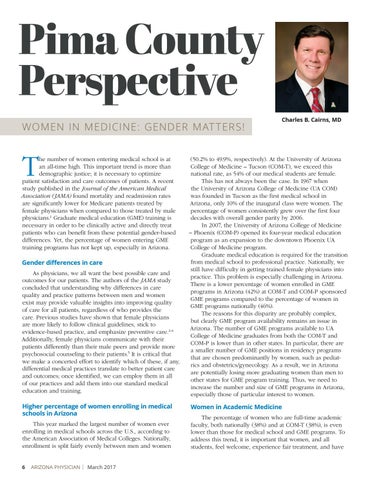Pima County Perspective WOMEN IN MEDICINE: GENDER MAT TER S!
T
he number of women entering medical school is at an all-time high. This important trend is more than demographic justice; it is necessary to optimize patient satisfaction and care outcomes of patients. A recent study published in the Journal of the American Medical Association (JAMA) found mortality and readmission rates are significantly lower for Medicare patients treated by female physicians when compared to those treated by male physicians.1 Graduate medical education (GME) training is necessary in order to be clinically active and directly treat patients who can benefit from these potential gender-based differences. Yet, the percentage of women entering GME training programs has not kept up, especially in Arizona.
Gender differences in care As physicians, we all want the best possible care and outcomes for our patients. The authors of the JAMA study concluded that understanding why differences in care quality and practice patterns between men and women exist may provide valuable insights into improving quality of care for all patients, regardless of who provides the care. Previous studies have shown that female physicians are more likely to follow clinical guidelines, stick to evidence-based practice, and emphasize preventive care.2-4 Additionally, female physicians communicate with their patients differently than their male peers and provide more psychosocial counseling to their patients.5 It is critical that we make a concerted effort to identify which of these, if any, differential medical practices translate to better patient care and outcomes; once identified, we can employ them in all of our practices and add them into our standard medical education and training.
Higher percentage of women enrolling in medical schools in Arizona This year marked the largest number of women ever enrolling in medical schools across the U.S., according to the American Association of Medical Colleges. Nationally, enrollment is split fairly evenly between men and women 6
ARIZONA PHYSICIAN | March 2017
Charles B. Cairns, MD
(50.2% to 49.9%, respectively). At the University of Arizona College of Medicine – Tucson (COM-T), we exceed this national rate, as 54% of our medical students are female. This has not always been the case. In 1967 when the University of Arizona College of Medicine (UA COM) was founded in Tucson as the first medical school in Arizona, only 10% of the inaugural class were women. The percentage of women consistently grew over the first four decades with overall gender parity by 2006. In 2007, the University of Arizona College of Medicine – Phoenix (COM-P) opened its four-year medical education program as an expansion to the downtown Phoenix UA College of Medicine program. Graduate medical education is required for the transition from medical school to professional practice. Nationally, we still have difficulty in getting trained female physicians into practice. This problem is especially challenging in Arizona. There is a lower percentage of women enrolled in GME programs in Arizona (42%) at COM-T and COM-P sponsored GME programs compared to the percentage of women in GME programs nationally (46%). The reasons for this disparity are probably complex, but clearly GME program availability remains an issue in Arizona. The number of GME programs available to UA College of Medicine graduates from both the COM-T and COM-P is lower than in other states. In particular, there are a smaller number of GME positions in residency programs that are chosen predominantly by women, such as pediatrics and obstetrics/gynecology. As a result, we in Arizona are potentially losing more graduating women than men to other states for GME program training. Thus, we need to increase the number and size of GME programs in Arizona, especially those of particular interest to women.
Women in Academic Medicine The percentage of women who are full-time academic faculty, both nationally (38%) and at COM-T (38%), is even lower than those for medical school and GME programs. To address this trend, it is important that women, and all students, feel welcome, experience fair treatment, and have
